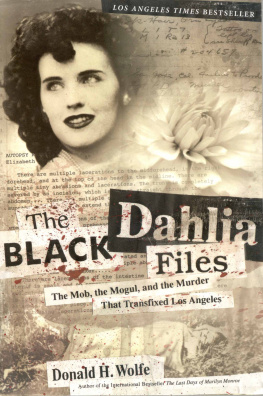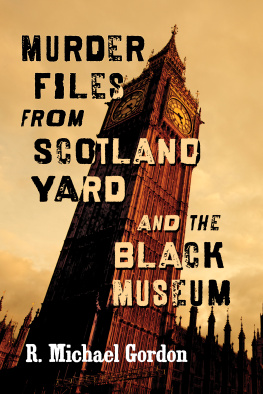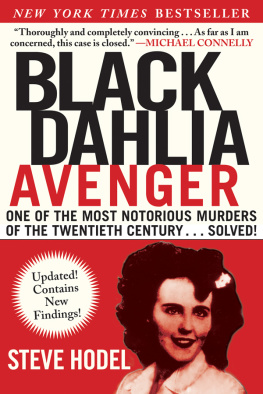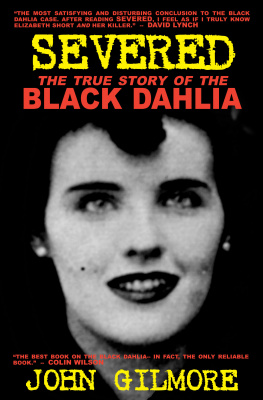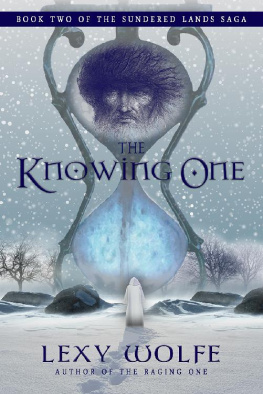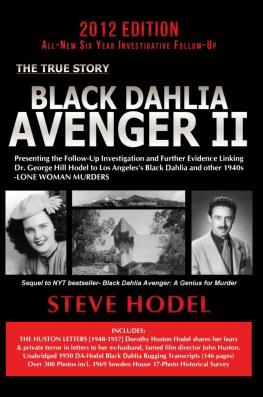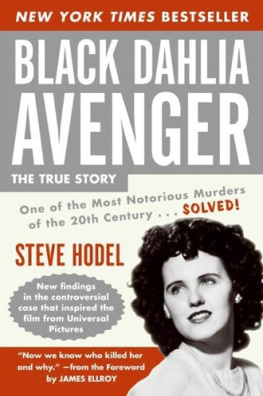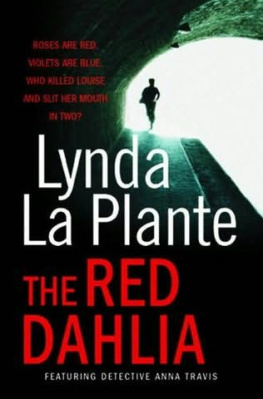To Vince Carter...
and all the honest cops who took the oath and kept it.
It was that name, Black Dahlia , that set this one off... just those words strung together in that order. Black is night, mysterious, forbidding; the Dahlia an exotic, mysterious flower. Any other name and it wouldnt have been the same.
Det. Sgt. Harry Hansen, LAPD
HOMICIDE DIVISION
Contents
THE BLACK DAHLIA murder occurred in Los Angeles more than fifty years ago, and the heinous crime was never solved. Often referred to as a riddle wrapped in a mystery inside an enigma, the puzzling homicide has continued to mystify many of us through the decades. A number of books have been written about the subject, with each author attempting to put together the pieces of the murder puzzle; however, after years of speculation, the Black Dahlia case remains stamped Open and Unsolved.
Time is often the enemy of truth and justiceevidence disappears, memories fade, witnesses dieand today the Black Dahlia murder is a cold, cold case. In our kinetic age the headlines of the day are soon forgotten and major stories, scandals, and unsolved mysteries are buried in civilizations scrap heap as the time machine rolls on and the public becomes immersed in the next scandal, the next war, the next cataclysmthe next murder.
But time can also be the friend of truth. The twentieth century is literally a storehouse of documentation once hidden from public view, and many of these yellowed documents hold the answers to yesterdays mysteries: After more than five decades, the evidence files and research material of the Kefauver Crime Commission are being indexed and slowly becoming available; under the Freedom of Information Act, more and more FBI and CIA files are being released; and although Chief Justice Warren had stated Not in your lifetime when he sealed the Warren Commission investigation papers more than forty years ago, many of the documents continue to become available.
In 2002, Los Angeles District Attorney, Steve Cooley, began establishing an archive of historic twentieth century crime investigations culled from the immense LAPD warehouse and the files of the district attorneys office. Included in the archive of notable cases were the Black Dahlia files, containing a wealth of testimony, documented evidence, and information that had never before been made public. For the first time, the district attorneys files reveal the bizarre modus operandi of the crime, establish a time-line of where the victim lived in the last years of her life, identify the people she knew, and provide a list of all the suspectsmany of whom were never previously mentioned by the police or the press. Most importantly, the files document the hidden motivation of the psychopathic killerthe dark secret hidden from the public for more than half a century. The files also reveal the Herculean effort by the upper echelons of the Los Angeles Police Department to cover up the nature of the crime. None of this extensive material had been available to former investigative journalists and researchers who spent years attempting to solve the baffling Black Dahlia murder with the limited information that was then accessible.
If the district attorneys archives had been available to John Gilmore when he wrote Severed: The True Story of the Black Dahlia Murder, he would have known just how close he was to solving the crime; Mary Pacios, who had known the Black Dahlia as a child and painted such an insightful portrait of her in Childhood Shadows: The Hidden Story of the Black Dahlia Murder, may have elected to eliminate some of the people on her suspect list; James Ellroy could have written a nonfiction book about the case, rather than a novel; and Janice Knowlton, author of Daddy Was the Black Dahlia Killer, would have been spared the anguish of believing her father was the murderer.
Steve Hodel, author of the most recent book on the case, Black Dahlia Avenger, also accused his father, George Hodel, of being the killer. Had he not completed his book just prior to the opening of the district attorneys archives, he could have learned that his father neither knew the Black Dahlia, nor had anything to do with the crime.
Born and raised in Los Angeles, I was fifteen years old when the Black Dahlia murder took place, and all the screaming headlines landed on our doorstep. Early on, I began collecting pieces of the Black Dahlia puzzle, and through the years I encountered reporters and police officers who had worked the case, including Will Fowler, the first reporter on the scene; Aggie Underwood, the ace Hearst crime reporter; Homicide detective Finis Brown; and Badge # 1John St. John.
I met former LAPD officer Vince Carter in 1992 while researching The Last Days of Marilyn Monroe. Having worked Administrative Vice at the time of the murder, Vince had a unique insight into the crime, as well as the depths of corruption within the upper echelons of the LAPD; and it was Vince who led me to the two LAPD intelligence officers who had discovered where the Black Dahlia murder took place and knew the identity of the killer.
I was first alerted to the district attorneys historical archives by Steve Lopez, a columnist for the Los Angeles Times. Lopez had heard rumors about the D.A.s Black Dahlia files and was the first to view them. After receiving permission from the district attorneys office to study and copy the documents, I soon realized they were a treasure trove of new and significant evidence. Some of the most valuable information was contained in the handwritten notes and memos of Lieutenant Frank Jemison, who had been the investigator when the Black Dahlia case was placed before the Grand Jury in 1949.
It was while studying Jemisons notes, more than half a century after they were written, that I knew I had found the pieces that were missing from the Black Dahlia puzzle. With all the pieces in place, I soon realized that they created a monstrous murder mosaic that was far more sinister than ever surmised. And clearly identifiable within the shadows of the assembled picture was the image of the killer himselfthe psychopath who had wandered the labyrinthine corridors of power and greed that crisscrossed the dark underworld of Los Angeles in 1947.
Donald H. Wolfe
THERE WASNT MUCH nightlife in Los Angeles back in the 1940s. Most people went to bed early. Even in Hollywood the streets were empty, and the town was pretty dead by 10:00 P.M . But as the city slept, the monster would come to life. The hulking behemoth invariably awoke around midnight, its flames jetting into the inky blackness. Every time they pushed the red button, it would jolt into action. The gears would begin to rotate, the wheels turn, and the platens clank into position. As the steely colossus pulsed into motion, the cavernous depths would begin to vibrate, and the roar became deafeningthe rollers turning faster and faster as the leaden plates whirled in a rhythmic crescendo of sound and motion.
The gigantic press was as tall as a two-story building. Rows of flames dried the ink as huge rolls of paper were consumed by the revolving plates that fed the printed pages to the cutter. Smoke from the flames would mingle with the solvent stench of ink and oil, filling the pressroom with its acrid odor.
Before they could roll the press, dozens of people would gather and edit the daily news about war and rumors of war, weddings, births, funerals, sports, movie stars, society, kidnappings, robberies, politicsand murder. And every twenty-four hours, at about midnight, theyd press the red button once again, and the monster would come to life, devour it all, and spit out the news through the flames that dried the ink and singed the truth, the lies, and Felix the Cat. Then the monster would fold it, bundle it up, and throw it down the chute, where the trucks waited in the night to distribute the
Next page
